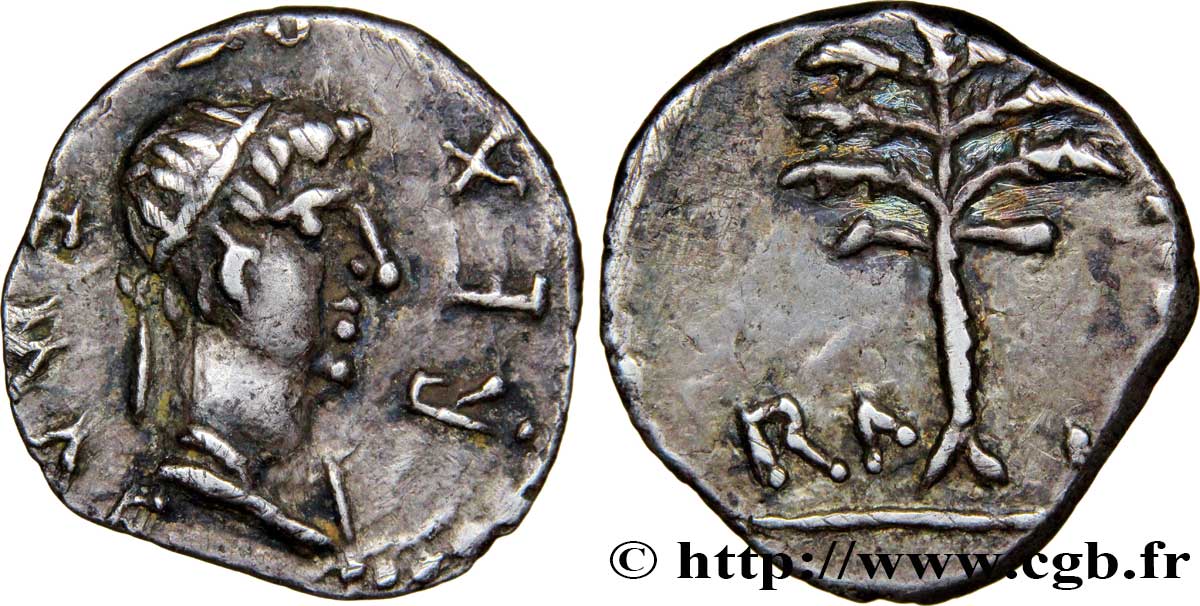v61_0046 - MAURETANIEN -MAURETANISCHES KÖNIGREICH - PTOLEMAEUS Denier
MONNAIES 61 (2014)
Startpreis : 750.00 €
Schätzung : 1 200.00 €
Erzielter Preis : 790.00 €
Anzahl der Gebote : 2
Höchstgebot : 800.00 €
Startpreis : 750.00 €
Schätzung : 1 200.00 €
Erzielter Preis : 790.00 €
Anzahl der Gebote : 2
Höchstgebot : 800.00 €
Type : Denier
Datum: an 1
Name der Münzstätte / Stadt : Césarée, Maurétanie
Metall : Silber
Durchmesser : 14 mm
Stempelstellung : 1 h.
Gewicht : 1,68 g.
Seltenheitsgrad : R3
Kommentare zum Erhaltungszustand:
Exemplaire sur un petit ovale et irrégulier, court sur les légendes. Beau portrait de Ptolémée. Joli revers bien venu à la frappe. Belle patine de collection ancienne avec des reflets dorés
N° im Nachschlagewerk :
Vorderseite
Titulatur der Vorderseite REX - [PTOLEMAEVS].
Beschreibung Vorderseite Buste diadémé et drapé de Ptolémée à droite, (A’01).
Übersetzung der Vorderseite “Rex Ptolemaeus”, (roi Ptolémée).
Rückseite
Titulatur der Rückseite R A - I.
Beschreibung Rückseite Palmier.
Übersetzung der Rückseite (règne an 6).
Kommentare
Poids très léger. Normalement, Ptolémée a succédé à son père Juba Ier en 23. Mais en fait, il est associé aux affaires depuis 20 après J.-C. La datation des années régnales devrait donc se faire à partir de cette date. Ce type semble beaucoup plus rare que ne le laissent supposer les ouvrages généraux. Sur cet exemplaire l’année régnale est difficile à interpréter. C’est normalement l’an I (20-21) mais le flan est court et le type est aussi connu pour l’an 2 (A. 251).
Very light weight. Normally Ptolemy succeeded his father Juba I in 23. But in fact he has been associated with affairs since 20 AD. The dating of the regnal years should therefore be done from this date. This type seems much rarer than general works suggest. On this example the regnal year is difficult to interpret. It is normally the year I (20-21) but the flan is short and the type is also known for the year 2 (A. 251)
Very light weight. Normally Ptolemy succeeded his father Juba I in 23. But in fact he has been associated with affairs since 20 AD. The dating of the regnal years should therefore be done from this date. This type seems much rarer than general works suggest. On this example the regnal year is difficult to interpret. It is normally the year I (20-21) but the flan is short and the type is also known for the year 2 (A. 251)








 Berichten über einen Fehler
Berichten über einen Fehler Die Seite drucken
Die Seite drucken Teilen meiner Auswahl
Teilen meiner Auswahl Stellen Sie eine Frage
Stellen Sie eine Frage Einlieferung/Verkauf
Einlieferung/Verkauf






